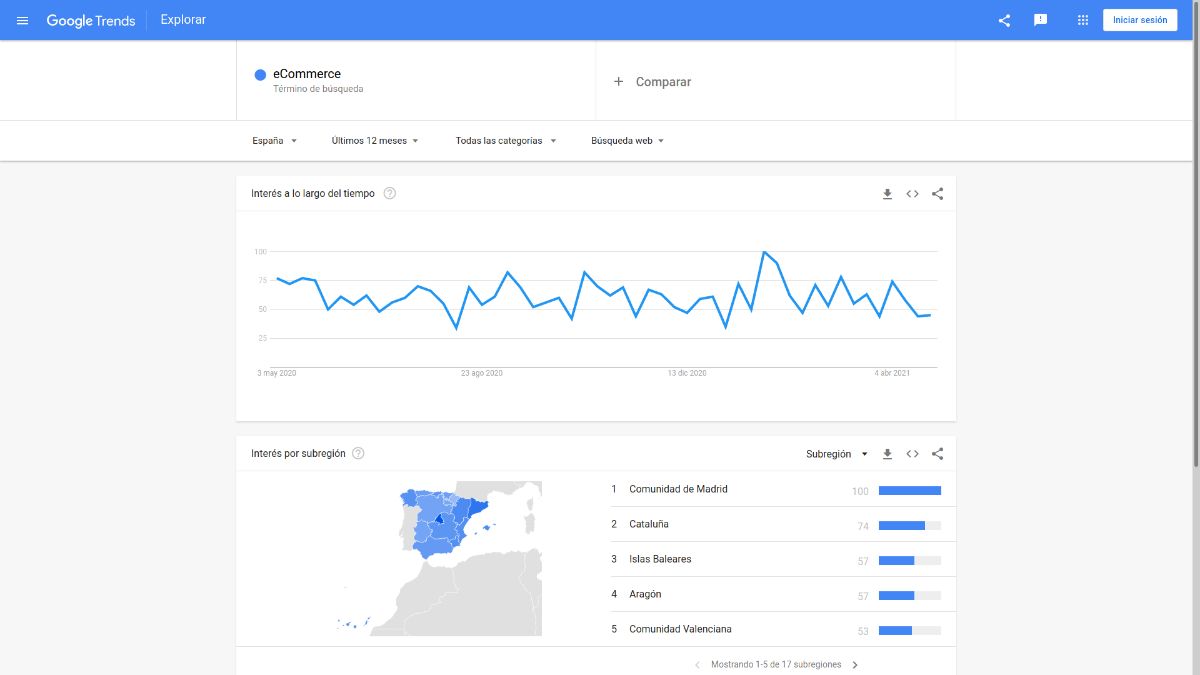
One of the tools most used by SEO experts is undoubtedly Google Trends. It is a free tool with which you can find out how "important" in searches a word (or set of words) is, thus helping to determine which could be the keywords that would work best in an online marketing strategy (and of positioning).
But What is Google Trends? What is it for? and how it works? Today we explain everything you need to know about this Google function that you may not know well.
What is Google Trends
The first time we were aware that Google Trends existed was in 2006, when the company released the tool in order to follow the evolution of searches based on keywords. In other words, it is an instrument that allows you to analyze a keyword in such a way that you know what type of searches it has for years, months, weeks or days.
Google Trends can be conceptualized as a tool that analyzes the popularity of words or terms to know if they are in trend or, on the contrary, are in decline. In addition, it also provides other data such as demographics, related searches, related topics, etc.
This Google feature is completely free and does not require prior registration or be linked to an email. Many SEO professionals or experts in digital marketing use it for their work with very good results, although we cannot tell you that it is something unique, they actually combine it with other tools (also free or paid).
What is Google Trends made of?

At first, when you get to the page and put a term to control, the data that the tool throws at you may overwhelm you, but it's actually very easy to understand. And it is not only going to show you the trend of that word that you have put, but much more. Specific:
- The volume of searches. That is, how that word behaves based on certain days, weeks, months, or even years.
- Search trends. This will tell you if the word you have placed is increasing or is decreasing its traffic. What is this for? Well, to determine if it is a word that can work now or in the short term (for example, Valentine's Day. It could increase in the middle of January but, after February 20, it will surely decline until disappearing for the following year).
- Forecast. This part of Google Trends is not very well known, but it will help you to know if that keyword may be trending up (or down) at any given time.
- Related searches. That is, words that are also searched related to the term you have put.
- Filter searches. The tool will allow you to search by geographic location, category, date ...
Why use this tool for your eCommerce
If you have an online store, even when you do not have a marketing strategy, Google Trends is essential for your day to day. And, although you may not believe it, it will help you to know what the new trends are, what users are looking for the most, etc. In other words, it can help you determine which products are going to be successful in your eCommerce.
For example, imagine that you have a shoe store and it turns out that in Google Trends the shoes of a certain brand are rising like foam. And you have them for sale and at cheaper prices than your competitors. Well, taking advantage of the pull and investing a little money in promoting that specific product can make your visits and sales go up because you are providing something that people are looking for.
It also helps you optimize your product files. And it is that with the most related keywords you will be able to elaborate the texts of each product so that the Google crawlers position you better (many still do not know that placing original and unique texts on the cards is much better than repeating the same as all the others ).
How to use Google Trends

And now we go to the practical, to know how the tool works. To do this, the first step is to go to the Google Trends tool. By default, in the upper right, it should put you as the country Spain (if you are in Spain) but you can actually change the country for where you are.
On the main screen you will see How are some examples shown but be careful, they are not data from Spain, but from the United States or worldwide, with which they may not help you.
If you go down a little more, you will know what are the recent world trends and, below, the searches by year (here you can find terms for Spain).
You will have seen that there is also a search box. That's where you should put a search term or topic. For example, eCommerce. Hit the magnifying glass (or Enter) and it will take you to the results page.
The results page shows you a lot of things. But what we consider most important is:
- Country. It will put Spain, but here you can also change it for the country that interests you.
- Last 12 months. By default this period always comes out, in the first search, but you can change it for several options: from 2004 to today, in the last five years, last 90 days, last 30 days, the last 7 days, last day, last 4 hours , last minute.
- All Categories. It allows you, especially for words or terms that may have several concepts, determine the exact search.
- Web search. By default you will have this, but you can also search by image, news, Google Shopping (perfect for eCommerce) or YouTube.
Right below, you will have the graph that will change as you modify the previous data.
As you can see, your keyword appears at the top, but if you look closely, there is a column that says "compare". This is used to place another keyword that interests you there and to know which of the two is stronger, or has more searches.
Then it appears to you the interest that this term has in the country, in such a way that they will tell you which autonomous communities are the ones that search for this term the most (this is ideal to know, for your community or city, what is most interesting, especially if your eCommerce is more local).

Lastly, you have two columns. One is that of related topics, that is, words or terms that may be related to the word you have searched for; on the other hand, you have related queries, that is, other keywords that are related to the one you have searched for and that may be a better option.